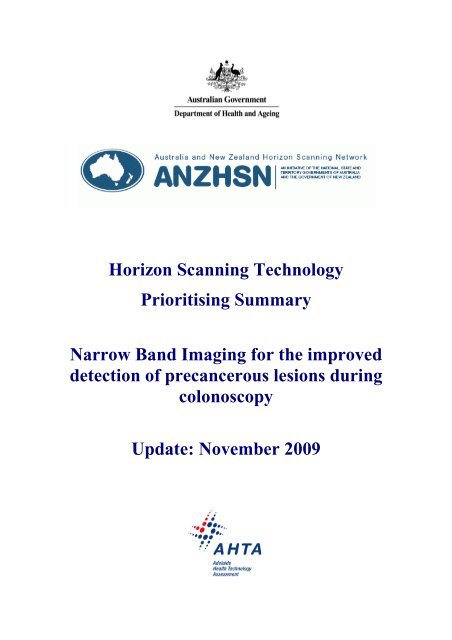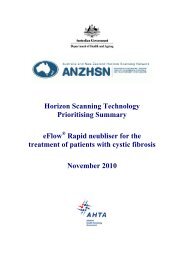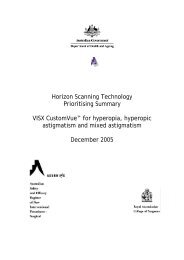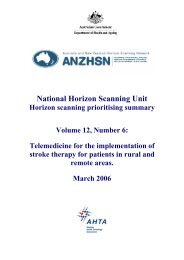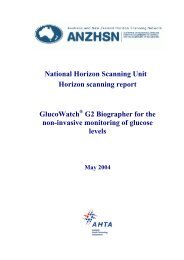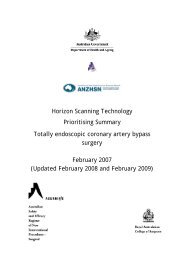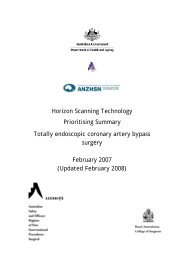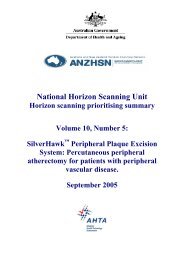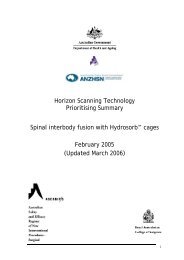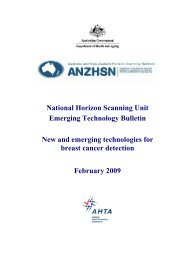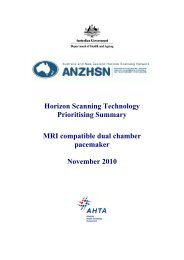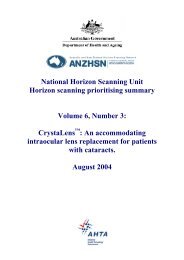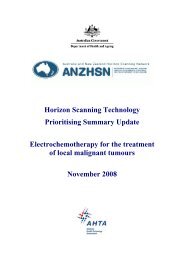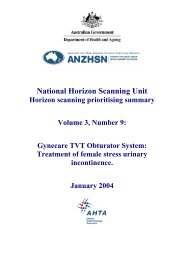Narrow Band Imaging for the improved detection of precancerous ...
Narrow Band Imaging for the improved detection of precancerous ...
Narrow Band Imaging for the improved detection of precancerous ...
You also want an ePaper? Increase the reach of your titles
YUMPU automatically turns print PDFs into web optimized ePapers that Google loves.
Horizon Scanning TechnologyPrioritising Summary<strong>Narrow</strong> <strong>Band</strong> <strong>Imaging</strong> <strong>for</strong> <strong>the</strong> <strong>improved</strong><strong>detection</strong> <strong>of</strong> <strong>precancerous</strong> lesions duringcolonoscopyUpdate: November 2009
© Commonwealth <strong>of</strong> Australia 2009ISBNPublications Approval Number:This work is copyright. You may download, display, print and reproduce this material inunaltered <strong>for</strong>m only (retaining this notice) <strong>for</strong> your personal, non-commercial use or usewithin your organisation. Apart from any use as permitted under <strong>the</strong> Copyright Act 1968, allo<strong>the</strong>r rights are reserved. Requests and inquiries concerning reproduction and rights should beaddressed to Commonwealth Copyright Administration, Attorney General’s Department,Robert Garran Offices, National Circuit, Canberra ACT 2600 or posted athttp://www.ag.gov.au/ccaElectronic copies can be obtained from http://www.horizonscanning.gov.auEnquiries about <strong>the</strong> content <strong>of</strong> <strong>the</strong> report should be directed to:HealthPACT SecretariatDepartment <strong>of</strong> Health and AgeingMDP 106GPO Box 9848Canberra ACT 2606AUSTRALIADISCLAIMER: This report is based on in<strong>for</strong>mation available at <strong>the</strong> time <strong>of</strong> research cannotbe expected to cover any developments arising from subsequent improvements healthtechnologies. This report is based on a limited literature search and is not a definitivestatement on <strong>the</strong> safety, effectiveness or cost-effectiveness <strong>of</strong> <strong>the</strong> health technology covered.The Commonwealth does not guarantee <strong>the</strong> accuracy, currency or completeness <strong>of</strong> <strong>the</strong>in<strong>for</strong>mation in this report. This report is not intended to be used as medical advice andintended to be used to diagnose, treat, cure or prevent any disease, nor should it be used<strong>the</strong>rapeutic purposes or as a substitute <strong>for</strong> a health pr<strong>of</strong>essional's advice. The Commonwealthdoes not accept any liability <strong>for</strong> any injury, loss or damage incurred by use <strong>of</strong> or reliance <strong>the</strong>in<strong>for</strong>mation.The production <strong>of</strong> this Horizon scanning prioritising summary was overseen by <strong>the</strong> HealthPolicy Advisory Committee on Technology (HealthPACT), a sub-committee <strong>of</strong> <strong>the</strong> MedicalServices Advisory Committee (MSAC). HealthPACT comprises representatives fromdepartments in all states and territories, <strong>the</strong> Australia and New Zealand governments; andASERNIP-S. The Australian Health Ministers’ Advisory Council (AHMAC) supportsHealthPACT through funding.This Horizon scanning prioritising summary was prepared by Adrian Purins, Linda Mundyand Pr<strong>of</strong>essor Janet Hiller from <strong>the</strong> National Horizon Scanning Unit, Adelaide HealthTechnology Assessment, Discipline <strong>of</strong> Public Health, School <strong>of</strong> Population Health andClinical Practice, Mail Drop DX 650 545, University <strong>of</strong> Adelaide, Adelaide, SA, 5005.
PRIORITISING SUMMARY (UPDATE 2009)REGISTER ID: 000414NAME OF TECHNOLOGY:PURPOSE AND TARGET GROUP:NARROW BAND IMAGINGIMAGING MODALITY FOR THE IMPROVEDDETECTION OF PRECANCEROUS LESIONS DURINGCOLONOSCOPY2009 SAFETY AND EFFECTIVENESS ISSUESA large amount <strong>of</strong> literature was published on NBI since <strong>the</strong> original prioritisingsummary was written in 2008. The highest quality evidence and larger studies arereviewed below.Two systematic reviews were published in 2009; one was focussed on NBI in <strong>the</strong>upper gastrointestinal tract and <strong>the</strong> o<strong>the</strong>r on NBI during colonoscopy.The first systematic review was based on thirteen papers <strong>for</strong> a variety <strong>of</strong> oesophagealconditions: squamous cell carcinoma (n =2), gastroesophageal reflux disease (GERD,n = 2) or Barrett’s oesophagus (BO, n = 9) and seven studies on stomach conditions.For early squamous cell carcinoma diagnosis, <strong>the</strong> review concluded that although NBIlooks promising <strong>the</strong>re is a lack <strong>of</strong> published in<strong>for</strong>mation to date <strong>for</strong> this application.For GERD, NBI showed a significant increase in sensitivity compared to standardendoscopy, which per<strong>for</strong>ms poorly in <strong>the</strong> diagnosis <strong>of</strong> GERD. This may reduce <strong>the</strong>need <strong>for</strong> <strong>the</strong> tests routinely per<strong>for</strong>med subsequent to standard endoscopy to confirmdiagnosis. BO diagnosis is not a focus <strong>of</strong> this summary but <strong>the</strong> systematic reviewfound that <strong>the</strong>re were conflicting results published <strong>for</strong> this condition, some studiesshowing better and some showing worse per<strong>for</strong>mance compared to standard methods.The studies on stomach conditions ei<strong>the</strong>r suffered from poor quality or did not show aclear benefit <strong>of</strong> NBI over normal endoscopy <strong>for</strong> diagnosis <strong>of</strong> <strong>the</strong>se conditions. Theauthors conclude that NBI shows promise <strong>for</strong> some <strong>of</strong> <strong>the</strong> conditions but largerrandomised studies are required to allow conclusions to be drawn about itseffectiveness (Curvers et al 2009) (Level I Diagnostic evidence).A systematic review on NBI use during colonoscopy identified 16 studies: one on <strong>the</strong><strong>detection</strong> <strong>of</strong> polyps, five on neoplasia <strong>detection</strong>, and 10 on lesion differentiation. Thereview <strong>of</strong> <strong>detection</strong> studies did not show an improvement in <strong>detection</strong> rates usingNBI, with only one <strong>of</strong> <strong>the</strong> three large randomised studies showing a significantincrease in <strong>detection</strong> when using NBI versus standard whitelight endoscopy (WLE).The authors note that <strong>the</strong> study showing a positive outcome <strong>for</strong> NBI was flawed indesign. The authors conclude that <strong>the</strong>re was no benefit shown in <strong>the</strong> current literatureregarding <strong>the</strong> use <strong>of</strong> NBI <strong>for</strong> <strong>the</strong> <strong>detection</strong> <strong>of</strong> neoplasia. The second part <strong>of</strong> <strong>the</strong> reviewfocussed on <strong>the</strong> use <strong>of</strong> NBI to differentiate lesions detected with WLE. The authorspooled <strong>the</strong> results <strong>of</strong> <strong>the</strong> reviewed studies and found that <strong>the</strong> overall sensitivity was<strong>Narrow</strong> band imaging <strong>for</strong> <strong>the</strong> <strong>detection</strong> <strong>of</strong> <strong>precancerous</strong> lesions: November 2009 Update 1
92% (95% CI [89, 94]) and overall specificity was 86% (95% CI [80, 91]). Thepooled results <strong>of</strong> a comparator technique called chromoendoscopy 1 found similardifferentiation results with a sensitivity <strong>of</strong> 91% (95% CI [83, 96]) and a specificity <strong>of</strong>89% (95% CI [83, 93]). The review also looked at four studies which reported oninter-operator agreement using NBI. The results showed good to perfect agreementbetween operators in four studies (κ values ranging from 0.64 to 1.0, with three <strong>of</strong> <strong>the</strong>four studies reporting very high κ values). Overall <strong>the</strong> review shows that NBI isunproven <strong>for</strong> <strong>the</strong> <strong>detection</strong> <strong>of</strong> neoplasia but comparable to established techniques <strong>for</strong><strong>the</strong> differentiation <strong>of</strong> lesions (van den Broek et al 2009) (Level I Diagnosticevidence).A study <strong>of</strong> 47 consecutive patients compared <strong>the</strong> ability <strong>of</strong> NBI to detect colorectallesions versus WLE. Patients confirmed to have neoplastic lesions were <strong>the</strong>n blindlyassessed using NBI at a separate institute. The procedure at <strong>the</strong> second instituteconsisted <strong>of</strong> analysing a segment <strong>of</strong> colon with only NBI <strong>the</strong>n reviewing <strong>the</strong> resultsfrom <strong>the</strong> first institute. If it was confirmed that a lesion was missed <strong>the</strong>n <strong>the</strong>colonoscope was switched to WLE mode and <strong>the</strong> operator attempted to investigate <strong>the</strong>discrepant lesions. Although NBI detected more neoplasia overall (NBI: 134/153 vsWLE: 116/153; p = 0.02), 12 per cent <strong>of</strong> <strong>the</strong> lesions detected by WLE were missedusing NBI. WLE missed 24 per cent <strong>of</strong> lesions detected by NBI (Uraoka et al 2009)(Level III-2 Diagnostic evidence).The ability <strong>of</strong> NBI to detect oesophageal lesions in a population with known lesionswas compared to WLE and WLE plus iodine staining. The population consisted <strong>of</strong> 90subjects with a mean age <strong>of</strong> 57 years. Lesions were confirmed with pathology. Theresults showed that iodine staining detected 100% (138/138) <strong>of</strong> <strong>the</strong> lesions, with NBIand WLE detecting 87.0% (120/138) and 75.4% (104/138) <strong>of</strong> <strong>the</strong> lesions, respectively(Huang et al 2009) (Level III-2 Diagnostic evidence).Using histology as <strong>the</strong> gold standard, NBI and lugol chomoendoscopy 2 werecompared <strong>for</strong> <strong>the</strong> <strong>detection</strong> <strong>of</strong> lesions in a patient population <strong>of</strong> 142 with head andneck squamous cell carcinoma (SCC). Sixteen patients were found to haveoesophageal lesions by NBI (21 lesions total, 15 clinically important). Nineteenadditional patients were found to have additional lesions by lugol chomoendoscopy(22 lesions total, 1 clinically important). Compared to <strong>the</strong> gold standard <strong>of</strong> histologyNBI showed a sensitivity <strong>of</strong> 90.9% (95 % CI [58.7, 99.8]) and a specificity <strong>of</strong> 95.4%(95 % CI [90.3, 98.3]) <strong>for</strong> <strong>the</strong> <strong>detection</strong> <strong>of</strong> clinically important lesions (Takenaka et al2009) (Level III-2 Diagnostic evidence).Watanabe et al (2009) used WLE to detect laryngeal lesions in a patient populationundergoing laryngoscopy at a Japanese clinic. WLE detected 35 suspected lesions in31 Chromoendoscopy is endoscopy using dyes to increase contrast <strong>of</strong> target lesions.2 Lugol’s Iodine is a stain that helps discriminate between lesions and normal tissue.3 The total number <strong>of</strong> patients assessed was not reported<strong>Narrow</strong> band imaging <strong>for</strong> <strong>the</strong> <strong>detection</strong> <strong>of</strong> <strong>precancerous</strong> lesions: November 2009 Update 2
34 patients. NBI was used to differentiate <strong>the</strong> lesions between malignant or nonmalignant.The gold standard used was histopathology. NBI detected 21/23 malignantlesions (sensitivity 91.3%) and correctly diagnosed 11/12 non-malignant lesions(specificity 91.6%) (Watanabe et al 2009) (Level III-2 Diagnostic evidence).Two systematic reviews and four primary studies are included in this update. Thereported sensitivity and specificity <strong>of</strong> NBI is high compared to o<strong>the</strong>r techniquesand/or standard techniques. Despite this, <strong>the</strong> value <strong>of</strong> this in<strong>for</strong>mation is questionableas <strong>the</strong> populations examined are ei<strong>the</strong>r very high risk <strong>for</strong>, or patients with,malignancies. The conclusions <strong>of</strong> <strong>the</strong> two systematic reviews show that NBI may beuseful <strong>for</strong> differentiating clinically significant from non-significant lesions. O<strong>the</strong>r uses<strong>of</strong> NBI are not supported by evidence or are at a preliminary stage <strong>of</strong> investigation.Long term follow up studies are needed to determine <strong>the</strong> effectiveness <strong>of</strong> NBI <strong>for</strong><strong>detection</strong> and differentiation.2009 COST IMPACTNo cost effectiveness in<strong>for</strong>mation was found during <strong>the</strong> preparation <strong>of</strong> this update.Olympus, <strong>the</strong> manufacturer <strong>of</strong> <strong>the</strong> CF-Q180 AL colonoscope used in several studies inthis prioritising summary, was contacted regarding <strong>the</strong> cost <strong>of</strong> a NBI capablecolonoscope system but at <strong>the</strong> time <strong>of</strong> publication no reply was <strong>for</strong>thcoming.The high definition model <strong>of</strong> this endoscope (CF-H180 AL) is quoted as having a cost<strong>of</strong> $US 70,500 ($36,000 <strong>for</strong> endoscope, $22,000 <strong>for</strong> processor (Evis Exera II), and$12,500 <strong>for</strong> <strong>the</strong> light source (Evis Exera II)) (Kwon et al 2009).2009 SUMMARY OF FINDINGSThe studies reviewed in this update support <strong>the</strong> use <strong>of</strong> NBI <strong>for</strong> <strong>the</strong> differentiation <strong>of</strong>malignant from non-malignant lesions <strong>of</strong> <strong>the</strong> colon. Based on current evidence, NBIalone is not a significant improvement over standard methods. Higher quality studiesin appropriate patient groups are needed to determine <strong>the</strong> effectiveness <strong>of</strong> NBIHEALTHPACT ACTION:NBI may be <strong>of</strong> limited use <strong>for</strong> <strong>the</strong> differentiation <strong>of</strong> benign or malignant polypsassociated with Barrett’s Oesophagus as general practice is to remove all polypsregardless. In addition, <strong>the</strong> majority <strong>of</strong> scopes available and in use in Australia have<strong>the</strong> capacity <strong>for</strong> NBI. HealthPACT have <strong>the</strong>re<strong>for</strong>e recommended that fur<strong>the</strong>rassessment <strong>of</strong> this technology is no longer warranted.NUMBER OF INCLUDED STUDIESTotal number <strong>of</strong> studiesLevel I diagnostic evidence 2Level III-2 diagnostic evidence 4<strong>Narrow</strong> band imaging <strong>for</strong> <strong>the</strong> <strong>detection</strong> <strong>of</strong> <strong>precancerous</strong> lesions: November 2009 Update 3
2009 REFERENCES:Curvers, W. L., van den Broek, F. J. et al (2009). 'Systematic review <strong>of</strong> narrow-bandimaging <strong>for</strong> <strong>the</strong> <strong>detection</strong> and differentiation <strong>of</strong> abnormalities in <strong>the</strong> esophagus andstomach (with video)', Gastrointest Endosc, 69 (2), 307-317.Huang, L. Y., Cui, J. et al (2009). '<strong>Narrow</strong>-band imaging in <strong>the</strong> diagnosis <strong>of</strong> earlyesophageal cancer and <strong>precancerous</strong> lesions', Chin Med J (Engl), 122 (7), 776-780.Kwon, R. S., Adler, D. G. et al (2009). 'High-resolution and high-magnificationendoscopes', Gastrointestinal Endoscopy, 69 (3, Part 1), 399-407.Takenaka, R.,Kawahara, Y. et al (2009). '<strong>Narrow</strong>-<strong>Band</strong> <strong>Imaging</strong> Provides Reliable Screening <strong>for</strong>Esophageal Malignancy in Patients With Head and Neck Cancers', Am JGastroenterol.Takenaka, R., Kawahara, Y. et al (2009). '<strong>Narrow</strong>-<strong>Band</strong> <strong>Imaging</strong> Provides ReliableScreening <strong>for</strong> Esophageal Malignancy in Patients With Head and Neck Cancers', Am JGastroenterol.Uraoka, T., Sano, Y. et al (2009). '<strong>Narrow</strong>-band imaging <strong>for</strong> improving colorectaladenoma <strong>detection</strong>: appropriate system function settings are required', Gut, 58 (4),604-605.van den Broek, F. J., Reitsma, J. B. et al (2009). 'Systematic review <strong>of</strong> narrow-bandimaging <strong>for</strong> <strong>the</strong> <strong>detection</strong> and differentiation <strong>of</strong> neoplastic and nonneoplastic lesionsin <strong>the</strong> colon (with videos)', Gastrointest Endosc, 69 (1), 124-135.Watanabe, A., Taniguchi, M. et al (2009). 'The value <strong>of</strong> narrow band imaging <strong>for</strong>early <strong>detection</strong> <strong>of</strong> laryngeal cancer', Eur Arch Otorhinolaryngol, 266 (7), 1017-1023.<strong>Narrow</strong> band imaging <strong>for</strong> <strong>the</strong> <strong>detection</strong> <strong>of</strong> <strong>precancerous</strong> lesions: November 2009 Update 4
REGISTER ID: 000414PRIORITISING SUMMARY (2008)NAME OF TECHNOLOGY:PURPOSE AND TARGET GROUP:NARROW BAND IMAGINGIMAGING MODALITY FOR THE IMPROVEDDETECTION OF PRECANCEROUS LESIONS DURINGCOLONOSCOPYSTAGE OF DEVELOPMENT (IN AUSTRALIA): Yet to emerge Established Experimental Established but changedindication or modification <strong>of</strong>technique Investigational Should be taken out <strong>of</strong> useNearly establishedAUSTRALIAN THERAPEUTIC GOODS ADMINISTRATION APPROVAL Yes ARTG number No Not applicableINTERNATIONAL UTILISATION:COUNTRYGermanyUnited StatesJapanTrials Underwayor CompletedLEVEL OF USELimited UseWidely DiffusedIMPACT SUMMARY:Companies that produce standard imaging equipment such as Olympus provide highresolution endoscopes capable <strong>of</strong> per<strong>for</strong>ming narrow band imaging. Although narrowband imaging is a relatively new imaging modality, it has been in use in Australia,mainly <strong>for</strong> patients with Barrett’s oesophagus. This prioritising summary examines<strong>the</strong> use <strong>of</strong> narrow band imaging <strong>for</strong> <strong>the</strong> new indication <strong>of</strong> <strong>the</strong> <strong>detection</strong> <strong>of</strong><strong>precancerous</strong> gastric and colorectal lesions. The technology would be made availablethrough specialist hospitals <strong>for</strong> patients undergoing a conventional bronchoscopy orendoscopy.2008 BACKGROUND<strong>Narrow</strong> band imaging (NBI) is an imaging technique that exploits <strong>the</strong> specifictransmissibility and absorption characteristics <strong>of</strong> specific wavelengths <strong>of</strong> light. Longer<strong>Narrow</strong> band imaging <strong>for</strong> <strong>the</strong> <strong>detection</strong> <strong>of</strong> <strong>precancerous</strong> lesions: November 2009 Update 5
wavelengths <strong>of</strong> light penetrate fur<strong>the</strong>r into tissue and different wavelengths areabsorbed differently by structures within <strong>the</strong> tissue. Specifically, blue light (415nm)allows <strong>the</strong> visualisation <strong>of</strong> <strong>the</strong> superficial capillary network as it does not penetrate <strong>the</strong>tissue to a great extent. Green light (540nm) penetrates fur<strong>the</strong>r into <strong>the</strong> tissue allowing<strong>the</strong> visualisation <strong>of</strong> deeper structures such as sub-epi<strong>the</strong>lial vessels. When imagesfrom <strong>the</strong> two light sources are combined a high contrast image <strong>of</strong> <strong>the</strong> tissue surface isgenerated.Figure 1 NBI image acquisition.Blue light only penetrates <strong>the</strong> near surface, whereas green light penetrates to deeper structures (left).The combined image shows <strong>the</strong> capillaries in brown and <strong>the</strong> underlying veins in blue (right).Lesions visualised with NBI can be categorised using two different techniques. Onemethod involves <strong>the</strong> analysis <strong>of</strong> microvasculature, with neoplastic lesions displayingincreased or abnormal microvessel density. A second method developed by Kudo et al(1994) involves analysis <strong>of</strong> <strong>the</strong> “pit pattern” <strong>of</strong> a lesion which results from <strong>the</strong> surfacestructures and superficial mucosal capillaries. The Kudo pit pattern allows <strong>the</strong> lesionto be graded on a scale from nonadenomatous to adenomatous 4 . These methods areapplicable to a variety <strong>of</strong> tissue types, including <strong>the</strong> colon.2008 CLINICAL NEED AND BURDEN OF DISEASEIn 2004 <strong>the</strong>re were 12,977 new cases <strong>of</strong> colorectal cancer diagnosed within Australia.According to <strong>the</strong> AIHW <strong>the</strong>re are no national prevalence data available <strong>for</strong> colorectalcancer (AIHW 2007). In 2006-07 <strong>the</strong>re were a total <strong>of</strong> 230,911 separations <strong>for</strong>colonoscopy as recorded under 4 categories (G43Z Complex Colonoscopy, G44AO<strong>the</strong>r Colonoscopy W Catastrophic or Severe CC, G44B O<strong>the</strong>r Colonoscopy W/OCatastrophic or Severe CC, G44C O<strong>the</strong>r Colonoscopy Sameday) (AIHW 2008). It isnot clear how many <strong>of</strong> <strong>the</strong>se separations are related to colorectal cancer diagnosis.4 Adenomatous lesions are not necessarily cancerous but have <strong>the</strong> risk <strong>of</strong> progression to malignancy.<strong>Narrow</strong> band imaging <strong>for</strong> <strong>the</strong> <strong>detection</strong> <strong>of</strong> <strong>precancerous</strong> lesions: November 2009 Update 6
2008 DIFFUSIONWhile NBI is currently in use in Australia <strong>for</strong> Barrett’s oesophagus, no evidence wasfound indicating NBI is used during colonoscopy <strong>for</strong> colorectal cancer diagnosis.However, a recent demonstration (August 2008) <strong>of</strong> <strong>the</strong> technique was conducted at <strong>the</strong>Royal Brisbane and Women’s Hospital, by Dr Omori, a gastrointestinal surgeon fromKawasaki Hospital, Japan.2008 COMPARATORSColonoscopy is <strong>the</strong> gold standard <strong>for</strong> diagnosis <strong>of</strong> potentially cancerous polyps. Being<strong>the</strong> gold standard, it is difficult to assess <strong>the</strong> accuracy <strong>of</strong> colonoscopy. As newertechniques emerge it is evident that colonoscopy is lacking in some areas such asamount <strong>of</strong> surface area <strong>of</strong> <strong>the</strong> colon able to be visualised (East et al 2007), <strong>the</strong>difficulty <strong>of</strong> detecting flat lesions with conventional colonoscopy (Dekker & Fockens2005), and <strong>the</strong> estimated polyp miss rate <strong>of</strong> 10-20 per cent (Bensen et al 1999;Robertson et al 2005).2008 SAFETY AND EFFECTIVENESS ISSUESSeveral studies have investigated <strong>the</strong> diagnostic ability <strong>of</strong> NBI <strong>for</strong> colorectal lesionscompared to conventional white light colonoscopy and histology. Adler investigatedNBI in a trial where patients presenting <strong>for</strong> routine colonoscopy diagnosis wererandomly assigned to ei<strong>the</strong>r conventional or NBI colonoscopy. The study involved401 eligible patients (200 NBI, 201 conventional colonoscopy) and found that <strong>the</strong><strong>detection</strong> rate <strong>of</strong> adenomas was higher in <strong>the</strong> NBI group (23%) than <strong>the</strong> conventionalgroup (17%), although this did not reach significance (p= 0.129). There was anapparent training effect involving <strong>the</strong> conventional method, where <strong>the</strong> first 100patients showed a 26.5 per cent adenoma <strong>detection</strong> rate <strong>for</strong> NBI and eight per cent <strong>for</strong>conventional colonoscopy, however <strong>the</strong> last 100 patients had an adenoma <strong>detection</strong>rate <strong>of</strong> 25.5 and 26.5 per cent <strong>for</strong> NBI and conventional colonoscopy, respectively.The authors speculated that <strong>the</strong> <strong>improved</strong> polyp <strong>detection</strong> using NBI may increase <strong>the</strong>ability <strong>of</strong> <strong>the</strong> clinicians to recognise polyps using conventional colonoscopy (Adler etal 2008) (Level III-2 diagnostic evidence).A second study randomised 276 patients presenting <strong>for</strong> routine colonoscopy to NBI orconventional colonoscopy. After ei<strong>the</strong>r NBI or conventional colonoscopy was carriedout a subsequent examination with conventional colonoscopy was per<strong>for</strong>med as <strong>the</strong>reference standard. The neoplasm miss rate was calculated against <strong>the</strong> referencestandard and was similar <strong>for</strong> both techniques (NBI = 17/135 (12.6%) vs conventionalcolonoscopy = 17/141 (12.1%). The miss rate <strong>for</strong> advanced adenomas was less thanone per cent (Kaltenbach et al 2008) (Level III-2 diagnostic evidence).Inoue et al investigated NBI versus conventional colonoscopy in a prospectivelyrecruited population <strong>of</strong> 243 patients who were randomly assigned to ei<strong>the</strong>r NBI orconventional colonoscopy. The procedure times <strong>for</strong> ei<strong>the</strong>r NBI or conventional<strong>Narrow</strong> band imaging <strong>for</strong> <strong>the</strong> <strong>detection</strong> <strong>of</strong> <strong>precancerous</strong> lesions: November 2009 Update 7
2008 ETHICAL, CULTURAL OR RELIGIOUS CONSIDERATIONSNo issues were identified/raised in <strong>the</strong> sources examined.2008 OTHER ISSUESNo issues were identified/raised in <strong>the</strong> sources examined.2008 SUMMARY OF FINDINGSBased on <strong>the</strong> medium quality evidence presented in this prioritising summary, NBIseems to be an improvement over conventional colonoscopy. Evidence has beenrapidly accumulating in recent times and a clear picture <strong>of</strong> <strong>the</strong> effectiveness <strong>of</strong> NBImay soon emerge.2008 HEALTHPACT ACTION:The majority <strong>of</strong> colonoscopes manufactured have <strong>the</strong> capability <strong>of</strong> per<strong>for</strong>ming ei<strong>the</strong>rconventional colonoscopy or narrow band imaging. There may be a learning curveinvolved in <strong>the</strong> use <strong>of</strong> narrow band imaging which may see <strong>the</strong> slow introduction <strong>of</strong>this technique. If <strong>the</strong> polyp <strong>detection</strong> rate is higher using narrow band imagingcompared to conventional colonoscopy, <strong>the</strong>n fur<strong>the</strong>r investment in this techniquewould be warranted. There<strong>for</strong>e HealthPACT have recommended that this technologybe monitored in 12-months time <strong>for</strong> fur<strong>the</strong>r in<strong>for</strong>mation.NUMBER OF INCLUDED STUDIESTotal number <strong>of</strong> studiesLevel III-2 diagnostic evidence 5REFERENCES:Adler, A., Pohl, H. et al (2008). 'A prospective randomised study on narrow-bandimaging versus conventional colonoscopy <strong>for</strong> adenoma <strong>detection</strong>: does narrow-bandimaging induce a learning effect?', Gut, 57 (1), 59-64.AIHW (2007). Incidence and prevalence <strong>of</strong> chronic diseases [Internet]. AustralianInstitute <strong>of</strong> Health and Welfare. Available from:http://www.aihw.gov.au/cdarf/data_pages/incidence_prevalence/index.cfm#CRC[Accessed 15th October].AIHW (2008). Separation, patient day and average length <strong>of</strong> stay statistics byAustralian Refined Diagnosis Related Group (AR-DRG) Version 5.0/5.1, Australia,1998-99 to 2006-07 [Internet]. Australian Institute <strong>of</strong> Health and Welfare. Availablefrom: http://www.aihw.gov.au/cognos/cgibin/ppdscgi.exe?DC=Q&E=/ahs/drgv5_9899-0607[Accessed 15th October].Bensen, S., Mott, L. A. et al (1999). 'The colonoscopic miss rate and true one-yearrecurrence <strong>of</strong> colorectal neoplastic polyps. Polyp Prevention Study Group', Am JGastroenterol, 94 (1), 194-199.Dekker, E. & Fockens, P. (2005). 'New imaging techniques at colonoscopy: tissuespectroscopy and narrow band imaging', Gastrointest Endosc Clin N Am, 15 (4), 703-714.<strong>Narrow</strong> band imaging <strong>for</strong> <strong>the</strong> <strong>detection</strong> <strong>of</strong> <strong>precancerous</strong> lesions: November 2009 Update 9


